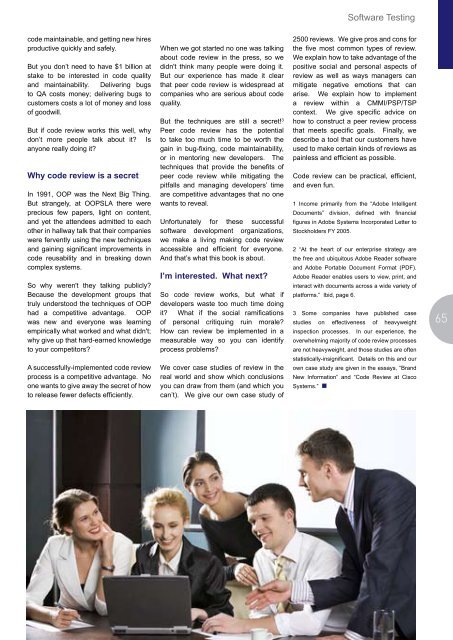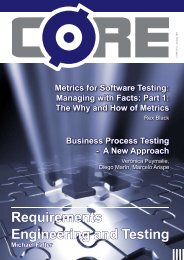Comparison of Change Management Systems
Comparison of Change Management Systems
Comparison of Change Management Systems
Create successful ePaper yourself
Turn your PDF publications into a flip-book with our unique Google optimized e-Paper software.
code maintainable, and getting new hires<br />
productive quickly and safely.<br />
But you don’t need to have $1 billion at<br />
stake to be interested in code quality<br />
and maintainability. Delivering bugs<br />
to QA costs money; delivering bugs to<br />
customers costs a lot <strong>of</strong> money and loss<br />
<strong>of</strong> goodwill.<br />
But if code review works this well, why<br />
don’t more people talk about it? Is<br />
anyone really doing it?<br />
Why code review is a secret<br />
In 1991, OOP was the Next Big Thing.<br />
But strangely, at OOPSLA there were<br />
precious few papers, light on content,<br />
and yet the attendees admitted to each<br />
other in hallway talk that their companies<br />
were fervently using the new techniques<br />
and gaining significant improvements in<br />
code reusability and in breaking down<br />
complex systems.<br />
So why weren't they talking publicly?<br />
Because the development groups that<br />
truly understood the techniques <strong>of</strong> OOP<br />
had a competitive advantage. OOP<br />
was new and everyone was learning<br />
empirically what worked and what didn't;<br />
why give up that hard-earned knowledge<br />
to your competitors?<br />
A successfully-implemented code review<br />
process is a competitive advantage. No<br />
one wants to give away the secret <strong>of</strong> how<br />
to release fewer defects efficiently.<br />
When we got started no one was talking<br />
about code review in the press, so we<br />
didn't think many people were doing it.<br />
But our experience has made it clear<br />
that peer code review is widespread at<br />
companies who are serious about code<br />
quality.<br />
But the techniques are still a secret! 3<br />
Peer code review has the potential<br />
to take too much time to be worth the<br />
gain in bug-fixing, code maintainability,<br />
or in mentoring new developers. The<br />
techniques that provide the benefits <strong>of</strong><br />
peer code review while mitigating the<br />
pitfalls and managing developers’ time<br />
are competitive advantages that no one<br />
wants to reveal.<br />
Unfortunately for these successful<br />
s<strong>of</strong>tware development organizations,<br />
we make a living making code review<br />
accessible and efficient for everyone.<br />
And that’s what this book is about.<br />
I’m interested. What next?<br />
So code review works, but what if<br />
developers waste too much time doing<br />
it? What if the social ramifications<br />
<strong>of</strong> personal critiquing ruin morale?<br />
How can review be implemented in a<br />
measurable way so you can identify<br />
process problems?<br />
We cover case studies <strong>of</strong> review in the<br />
real world and show which conclusions<br />
you can draw from them (and which you<br />
can’t). We give our own case study <strong>of</strong><br />
S<strong>of</strong>tware Testing<br />
2500 reviews. We give pros and cons for<br />
the five most common types <strong>of</strong> review.<br />
We explain how to take advantage <strong>of</strong> the<br />
positive social and personal aspects <strong>of</strong><br />
review as well as ways managers can<br />
mitigate negative emotions that can<br />
arise. We explain how to implement<br />
a review within a CMMI/PSP/TSP<br />
context. We give specific advice on<br />
how to construct a peer review process<br />
that meets specific goals. Finally, we<br />
describe a tool that our customers have<br />
used to make certain kinds <strong>of</strong> reviews as<br />
painless and efficient as possible.<br />
Code review can be practical, efficient,<br />
and even fun.<br />
1 Income primarily from the “Adobe Intelligent<br />
Documents” division, defined with financial<br />
figures in Adobe <strong>Systems</strong> Incorporated Letter to<br />
Stockholders FY 2005.<br />
2 “At the heart <strong>of</strong> our enterprise strategy are<br />
the free and ubiquitous Adobe Reader s<strong>of</strong>tware<br />
and Adobe Portable Document Format (PDF).<br />
Adobe Reader enables users to view, print, and<br />
interact with documents across a wide variety <strong>of</strong><br />
platforms.” Ibid, page 6.<br />
3 Some companies have published case<br />
studies on effectiveness <strong>of</strong> heavyweight<br />
inspection processes. In our experience, the<br />
overwhelming majority <strong>of</strong> code review processes<br />
are not heavyweight, and those studies are <strong>of</strong>ten<br />
statistically-insignificant. Details on this and our<br />
own case study are given in the essays, “Brand<br />
New Information” and “Code Review at Cisco<br />
<strong>Systems</strong>.”<br />
65



